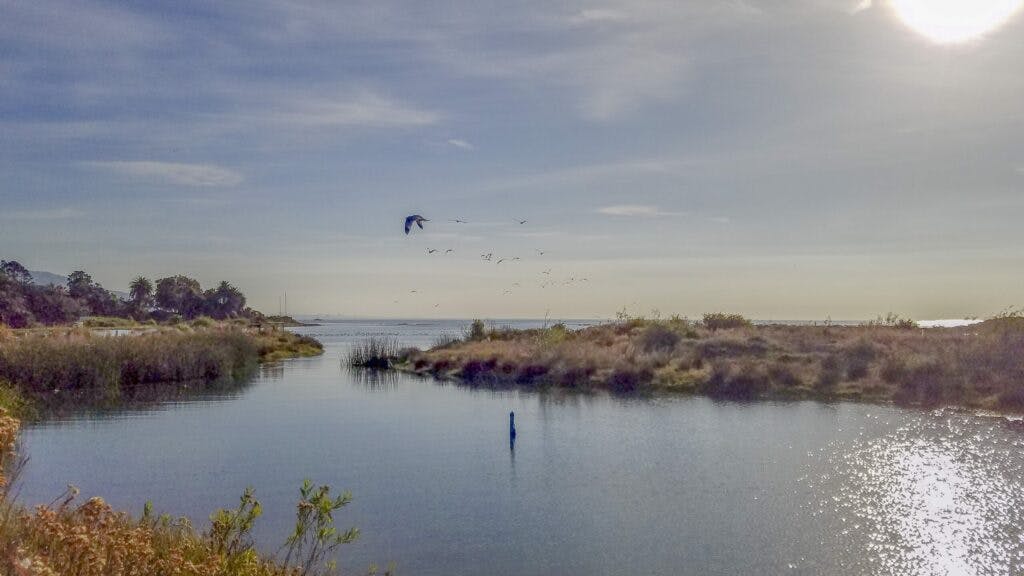- English
- Spanish
- Korean
- Filipino
- Armenian
- Chinese (Simplified)
Coastal Wetlands
Prev
Freshwater Aquatic & Riparian
Next
Rocky Reefs
Habitat Overview
Coastal wetlands are low-lying areas of land that are frequently and regularly inundated with fresh and/or ocean water. How much water they receive, the source of that water, as well as the elevation, slope, and sediment have profound effects on the presence and distribution of vegetation and wildlife. Coastal wetlands are renowned for their ability to capture sediment, withdraw nutrients, slow the flow of water, and through a mixture of habitats, within them, support a great diversity of wildlife.
Most coastal wetlands in Santa Monica Bay are found near the mouths of canyons along the Santa Monica Mountains in Malibu. These ‘lagoons’ are often closed to the ocean in the summer and open when winter rains breach the beach. Trancas, Zuma, Malibu, and Topanga lagoons are some of the most prominent along this section of the coast. In the middle of the Bay where the land is flatter the water used to spread out more, and this led to a large complex of salt and freshwater marshes, mudflats, salt pans, and open water. Much of this coastal wetland was lost to changes in water flows, and urban development. A remnant of that once expansive system is the Ballona Wetlands Ecological Reserve.
Status
| Indicator | Score | Confidence |
|---|---|---|
| Habitat Extent | High | |
| Habitat Vulnerability | Not Scored | |
| Structure & Ecological Disturbance | Moderate, High | |
| Biological Response | Not Scored |
Per the Coastal Wetlands habitat's 2015 condition, see below for condition details.
Why Is a Healthy Coastal Wetlands Habitat Important?
The prolonged presence of water creates conditions that favor the growth of specially adapted plants (hydrophytes) and promote the development of characteristic wetland (hydric) soils (USEPA CWA Section 404).
Species Habitat
Coastal wetlands are among the most productive ecosystems, providing an essential habitat for a variety of species, including birds, fish, reptiles, invertebrates, mammals, and vegetation.
In addition to the species common to most coastal wetlands in Southern California, the Bay’s wetlands are home to several protected species, including, but not limited to, Belding’s savannah sparrow (Passerculus sandwichensis beldingi, state endangered species), Tidewater Goby (Eucyclogobius newberryi, federal endangered species), and Southern Steelhead Trout (Oncorhynchus mykiss irideus, federal endangered species).
Primary Challenges
Human Activities and Invasive Species
Urban development, oil and gas exploration, the construction of Marina del Rey, channelization, dredging, filling, and other human activities have reduced wetland acreage in the Bay watershed. While federal and state policies are in place to minimize future loss, and while much of the remaining habitat is under public ownership, restoration efforts are critical to preserving the diversity found in these habitats.
The Ballona Wetlands Restoration Project, a large-scale effort to rehabilitate the Ballona Wetlands Ecological Reserve, is currently in the planning and permitting stages. Smaller-scale restoration efforts to remove invasive species at the Reserve have been led by Friends of Ballona Wetlands, TBF, and CDFW.
2015 Habitat Condition
Read more about the coastal wetlands’ habitat conditions through our data and research published in the 2015 State of the Bay Report
Taking Action
Learn more about the work being done by SMBNEP partners and The Bay Foundation to protect and improve the Bay’s soft bottom habitats.
